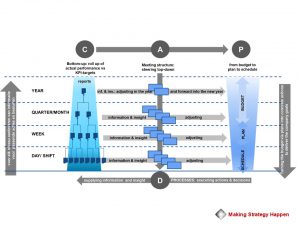Isn’t there an opportunity in every challenge? – Part 5 – Performance Management Systems
Steering the company in volatile times
The coronavirus pandemic has caused a swell across business markets, in terms of both volatility and financial risk. To sail the company ship through these rough economic seas, your compass needs to be accurate and the quality of decisions and actions taken must be right. All crew members need the appropriate information to make the right decisions and act accordingly. Unfortunately, this is seldom the case. More often than not the crew sails blindfolded, unable to act effectively; the company drifts off course and targets are not met.
The Performance Management System
This is where the Performance Management System (PMS) comes in. In Part 1 we focused on an appealing vision and ambition – the dot on the horizon to sail to. In Part 2 we considered how to align the cost structure with this vision. In Part 3 we deployed the vision and ambition through all organisational levels and made sure that everyone in the company was aligned and owned the targets. In Part 4 we looked at how to design the key business processes. The PMS ties all of this together.
The PMS is like the control panel in the bridge of a ship. In fact, it is a set of fast and slow Plan-Do-Check-Act cycles. PDCA – the good old Deming cycle. The basic principle is shown below.
 On the right is the “P” column: turning the annual budget into a daily activity schedule. The lower horizontal part is the “D” area: the actual business processes where activities are done. On the left is the “C” column: reporting actual performance against the targets. In the middle is the “A” column: the daily, weekly, monthly, quarterly and annual meetings in which actions are formulated and decisions taken to drive actual performance to KPI targets based on the information and insights supplied through the reports. The fast cycles occur shift-to-shift, day-to-day and week-to-week. Above that the slower cycles are active.
On the right is the “P” column: turning the annual budget into a daily activity schedule. The lower horizontal part is the “D” area: the actual business processes where activities are done. On the left is the “C” column: reporting actual performance against the targets. In the middle is the “A” column: the daily, weekly, monthly, quarterly and annual meetings in which actions are formulated and decisions taken to drive actual performance to KPI targets based on the information and insights supplied through the reports. The fast cycles occur shift-to-shift, day-to-day and week-to-week. Above that the slower cycles are active.
It is important to ensure that the PDCA cycles are closed and that the faster and slower ones work in synch. Closed PDCA cycles drive actual performance to KPI targets.
Purpose of the Performance Management System
The purpose of the Performance Management System is to (1) manage the organisation and the business processes to ensure delivery of the company goals, (2) support the development and continuity of effective behaviour of people at all levels in the organisation, and (3) facilitate people to work as “one team – one goal”.



